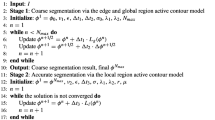Abstract
A novel region-based active contour model is proposed in this paper. By using the image local information in the energy function, our model is able to efficiently segment images with intensity inhomogeneity. Moreover, the proposed model is convex. So, it is independent of the initial condition. Furthermore, the energy function of the proposed model is minimized in a computationally efficient way by using the Chambolle method.
Access this chapter
Tax calculation will be finalised at checkout
Purchases are for personal use only
Preview
Unable to display preview. Download preview PDF.
Similar content being viewed by others
References
Xu, C., Pham, D.L., Prince, J.L.: Medical Image Segmentation Using Deformable Models. In: SPIE Handbook on Medical Imaging: Medical Image Analysis, pp. 29–174 (2000)
Boscolo, R., Brown, M., McNitt-Gray, M.: Medical Image Segmentation with Knowledge-guided Robust Active Contours. Radiographics 22(2), 437–448 (2002)
Wang, L., Li, C., Sun, Q., Xia, D., Kao, C.: Brain MR Image Segmentation Using Local and Global Intensity Fitting Active Contours/Surfaces. In: Metaxas, D., Axel, L., Fichtinger, G., Székely, G. (eds.) MICCAI 2008, Part I. LNCS, vol. 5241, pp. 384–392. Springer, Heidelberg (2008)
Kass, M., Witkin, A., Terzopoulos, D.: Snakes: Active Contour Models. Inter. J. Comp. Vi. 1, 321–332 (1988)
Caselles, V., Catte, F., Coll, T., Dibos, F.: A Geometric Model for Active contours in Image Processing. Numerische Mathematik 66, 1–33 (1993)
Malladi, R., Sethian, J.A., Vemuri, B.C.: A topology independent shape modeling scheme. In: Proc. SPIE Conf. Geo. Methods Comp. Vi. II, vol. 2031, pp. 246–258 (1993)
Caselles, V., Kimmel, R., Spiro, G.: On Geodesic Active Contours. The Inter. J. Comp. Vi. 22(1), 61–79 (1997)
Paragios, N., Deriche, R.: Geodesic Active Regions and Level Set Methods for Supervised Texture Segmentation. Inter. J. Comp. Vi. 46(3), 223 (2002)
Ronfard, R.: Region-based Strategies for Active Contour Models. Inter. J. Comp. Vi. 13(2), 229–251 (1994)
Chen, Y., Guo, W., Huang, F., Wilson, D.: Using Prior Shape and Points in Medical Image Segmentation. In: Rangarajan, A., Figueiredo, M.A.T., Zerubia, J. (eds.) EMMCVPR 2003. LNCS, vol. 2683, pp. 625–632. Springer, Heidelberg (2003)
Chan, T., Vese, L.: Active Contour without Edges. IEEE Trans. Ima. Process. 10(2), 266–277 (2001)
Mumford, D., Shah, J.: Optimal Approximations by Piecewise Smooth Function and Variation Problems. Comm. On Pure and App. Math. 42(5), 577–685 (1988)
Chan, T., Esedoglu, S., Nikolova, M.: Algorithms for Finding Global Minimizers of Image Segmentation and Denoising Models. J. App. Math. 66, 1632–1648 (2006)
Bresson, X., Esedoglu, S., Vandergheynst, P., Thiran, J., Osher, S.: Fast Global Minimization of The Active Contour/Snake Model. J. Math. Ima. Vi. 28(2), 151–167 (2007)
Osher, S., Sethian, J.A.: Front Propagating with curvature dependent speed: Algorithms Based on Hamilton-Jacobi Formulation. J. Com. Phy. 79, 12–49 (1988)
Shi,Y.,Karl, W.C.: A Fast Level Set Method Without Solving PDEs. In: ICASSP 2005 (2005)
Vese, L., Chan, T.: A Multiphase Level Set Framework for Image Segmentation Using The Mumford and Shah Model. Inter. J. Comp. Vi. 50(3), 271–293 (2002)
Li, C., Kao, C., Gore, J., Ding, Z.: Implicit Active Driven by Local Binary Fitting Energy. In: Proc. IEEE Conf. Comp. Vi. and Pat. Recog., pp. 1–7 (2007)
Zhang, K., Song, H., Zhang, L.: Active contours driven by local image fitting energy. Pat. Recog., 1199–1206 (2010)
Chambolle, A.: An Algorithm for Total Variation Minimization and Applications. J. Math. Imag. and Vi. 20(1-2), 89–97 (2004)
Aubert, G., Kornprobst, P.: Mathematical Problems in Image Processing: Partial Differential Equations and The Calculus of Variations. Springer, Heidelberg (2002)
Author information
Authors and Affiliations
Editor information
Editors and Affiliations
Rights and permissions
Copyright information
© 2011 Springer-Verlag Berlin Heidelberg
About this paper
Cite this paper
Thieu, Q.T., Luong, M., Rocchisani, JM., Viennet, E. (2011). A Convex Active Contour Region-Based Model for Image Segmentation. In: Real, P., Diaz-Pernil, D., Molina-Abril, H., Berciano, A., Kropatsch, W. (eds) Computer Analysis of Images and Patterns. CAIP 2011. Lecture Notes in Computer Science, vol 6854. Springer, Berlin, Heidelberg. https://doi.org/10.1007/978-3-642-23672-3_17
Download citation
DOI: https://doi.org/10.1007/978-3-642-23672-3_17
Publisher Name: Springer, Berlin, Heidelberg
Print ISBN: 978-3-642-23671-6
Online ISBN: 978-3-642-23672-3
eBook Packages: Computer ScienceComputer Science (R0)




